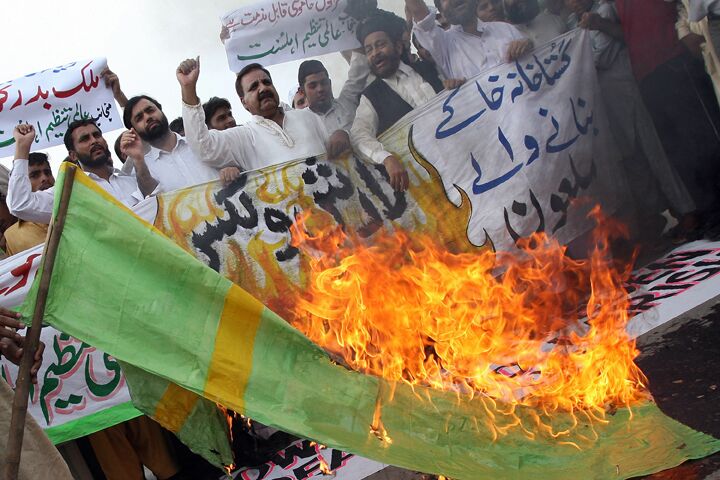
Europe: Is Another Cartoon Crisis Imminent?
On August 19, the Swedish daily Nerikes Allehanda published a cartoon depicting the prophet Mohammed’s head on the body of a dog. Though more than two weeks have passed, and the issue hasn’t yet spiraled into an international incident replete with violent riots and mass chaos, this doesn’t mean a crisis isn’t lurking around the corner.
This is not to say Muslims haven’t reacted. Last week the governments of both Pakistan and Iran summoned Swedish diplomats for meetings, at which they lodged formal complaints. “Regrettably, the tendency among some Europeans to mix the freedom of expression with an outright and deliberate insult to 1.3 billion Muslims in the world is on the rise,” the Pakistani Foreign Ministry said, in a jab at the broader European community.
In addition to complaints from Iran and Pakistan, Ekmeleddin Ihsanoglu, secretary general of the Organization of the Islamic Conference in Saudi Arabia, also condemned the publication of the “blasphemous” cartoon, saying that it was intentionally concocted “to solely insult and arouse the sentiments of Muslims,” according to press tv.
Beyond these complaints, angry Muslims in Sweden have been staging protests outside the headquarters of Nerikes Allehanda in the city of Orebro. The largest rally to date occurred last Friday, when an estimated 300 upset protesters gathered to demand an apology from the chief editor.
On the whole, however, the response to the cartoon in both Sweden and Muslim communities around the world has been benign compared to the cartoon crisis of 2006, which led to boycotts of European goods, massive riots in Muslim countries, and attacks on European embassies and consulates across the Middle East. But that doesn’t mean the threat of large-scale riots and violence has passed. In fact, as think tank Stratfor highlighted in an article last Thursday, the 2006 cartoon crisis fomented for months before it finally birthed the tidal wave of violence that rolled across the Muslim world:
The Danish cartoon controversy began in earnest when Muslim leaders used the drawing to incite anger among their congregations and constituencies in the Middle East. However, it took about six months and several reprints of the cartoon in other newspapers before street demonstrations instigated by clerics and community leaders broke out across the Muslim world.
Stratfor warned in a separate article on Friday that the potential remains high for Muslim leaders to further exploit the Swedish cartoon issue in coming weeks and months as a rallying cry for Muslims both inside and outside of Europe. Muslim leaders could yet unsheathe the issue later as a prod to incite anti-Europe antagonism among their Islamic followers.
In addition to that possibility, there’s another critical reason why this controversy may not yet be dead and buried.
That reason: Europeans, in this case Sweden and the newspaper that published the cartoon, are refusing to apologize to Muslims for printing the controversial depiction. Despite the heated complaints from Iran, Pakistan and the Organization of the Islamic Conference, and the protests by Swedish Muslims, neither the Swedish government nor the newspaper has apologized for printing the depiction.
On Friday, Fox News reported that although Ulf Johansson, the editor in chief of Nerikes Allehanda, met with Jamal Lamhamdi, the chairman of the Islamic cultural center in Orebro, and expressed regret that Muslims were offended by the cartoon, he refused to apologize. “They say they are offended and I regret that, because our purpose was not to offend anyone,” Johansson stated. “But they are asking for an apology and a promise that I never again publish a similar image … and that I cannot do.”
In an effort to avert Muslim anger, the prime minister of Sweden called for mutual respect between Muslims, Christians and nonreligious groups, telling his people that Sweden was a place where Muslims and Christians can live side by side. The prime minister employed all manner of tact and diplomacy to assuage Muslim outrage, but he simply refused to outright apologize.
In the coming months and years, we can expect this kind of mental fortitude against Islamic patronization to become the abiding mindset of Europeans.
Even now there is a palpable swing occurring in Europe toward right-wing ideology; in many regions of the Continent, especially Germany, the tension between native Europeans and foreigners is mounting. Europeans are becoming as disgruntled with the Muslims as the Muslims are with the Europeans.
Watch for this situation to simmer and eventually move toward disaster.
The evolution of relations between Europe and the Islamic world is one of the most important trends we could watch. The Continent is in desperate need of a catalyst for unification, something that will convince Europeans that they must more fully integrate. The pushy, provocative and powerful threat of Islam could be just what’s required to stir Europe to unite.
